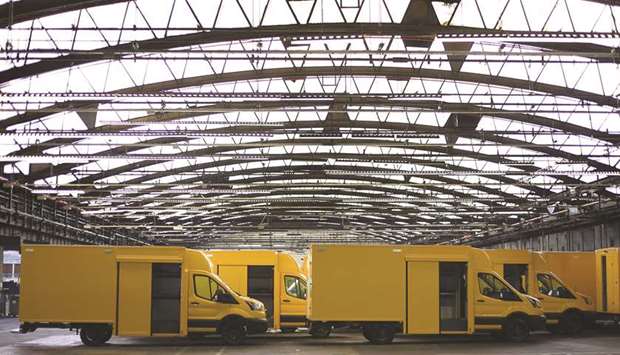Deutsche Post AG will start running a fleet of electric vans with range-extending fuel-cell technology from 2020, potentially creating a follow-up success to the German mail operator’s own no-frills delivery vehicle that left Volkswagen AG and Daimler AG trailing.
Five years ago, Deutsche Post acquired startup StreetScooter to develop bare-bones electric vans after its requests for a low-cost vehicle fell on deaf ears. The electric fleet has grown to more than 9,000 and the company sells the vehicles to third parties, irking incumbent manufacturers.
The new H2 Panel Van, a bigger version of the StreetScooter Work XL and the first of its kind according to the company, will have more room and payload with a range of as much as 500km (310 miles). It’ll hit roads next year when the first batch of 100 vehicles will be handed over to the company’s DHL Express unit in 2020 and 2021.
“We’re convinced that fuel-cell technology will grow in importance,” Fabian Schmidt, chief technical officer at StreetScooter GmbH, said Friday in a statement. “We’re entering a new phase of innovation and are starting a new chapter of our growth story.”
The fuel-cell fleet could quickly grow to 500 vehicles, according to the unit’s German head Markus Reckling. While the hydrogen model will be deployed in-house only for the time being, StreetScooter is already selling hundreds of smaller electric models to customers from the UK to Japan.
Deutsche Post has been looking at potentially selling StreetScooter — a university spinoff it bought in 2014 — for at least a year. It also roped in Ford Motor Co to supply the chassis for the delivery van, enabling larger-scale production and sales.
Van sales are set to balloon as Internet shopping becomes more prevalent and an increasing number of people move to cities. Demand in the US, Europe and China are set to jump by three-quarters through 2040 to 8.5mn vehicles annually, according to BloombergNEF’s “Electric Vehicle Outlook 2019.”
Vans will move toward electrification faster than mid- or heavy-duty trucks due to their lighter payloads and shorter distances, the report says.
Competition for access to increasingly emissions-restricted city centres is picking up. Daimler has started deliveries of its eVito, and an electric version of its larger Sprinter will follow this year. Ford and Amazon.com Inc are investing $500mn in US start-up Rivian, which electrifies trucks and SUVs. Workhorse Group Inc is competing for a contract worth as much as $6.3bn to supply next-generation mail trucks to the US Postal Service. In the UK, UPS and Royal Mail are trialling battery vans from Arrival Electric Vehicle.
Fuel cells create energy from the chemical reaction that combines hydrogen and oxygen to power an electric motor. The process only emits water. While fuel cells offer the prospect of more range and faster recharging than battery-powered electric vehicles, they require a complex infrastructure for storing and refuelling the hydrogen tanks.
For DHL, the extra range means the vehicle will be better suited to handle deliveries of parcels with mixed priorities.
Some express services are more urgent than others, leaving drivers unable to pick the best route to maximise range but to hand over first things first. The new vans will cover routes too long for the battery-only vehicles.

Fully assembled StreetScooter emission-free electric delivery trucks, manufactured by Ford Motor Co in co-operation with Deutsche Post, stand at the Ford factory in Cologne, Germany. Five years ago, Deutsche Post acquired startup StreetScooter to develop bare-bones electric vans after its requests for a low-cost vehicle fell on deaf ears. The electric fleet has now grown to more than 9,000 and the company sells the vehicles to third parties, irking incumbent manufacturers.
